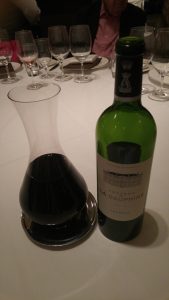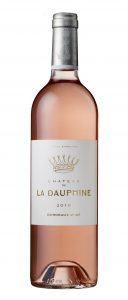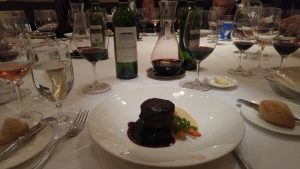
Fronsac, one of 3 areas comprising the Libourne region (Saint Emilion and Pomerol are the other 2) of Bordeaux’s Right Bank has enjoyed a 2000 year history of winemaking. By the eighteenth century, wines from Fronsac were considered to be the finest, and commanded prices that exceeded even those from Saint Emilion and Pomerol. Wines made in Fronsac were the preferred wine of the kings and the over two century-old Chateau de la Dauphine, (one of Fronsac’s most distinguished vineyards) was named in honor of the then princess of the time, Maria Josepha of Saxony. Chateau de la Dauphine was purchased by the Labrune family in 2015. This now biodynamic and organic vineyard cultivates 130 acres of vines, making it one of the largest within the Libourne region.

The semi-circular shaped vineyard has 14 types of soil. There is a 60 meter difference between the lowest and highest areas of vine cultivation. The vineyard meticulously applies the principles of biodynamic planting, cultivation and harvesting during wine production. The vineyard received its organic agriculture certification in 2015. Every aspect of the winemaking process, from the plowing to the canopy management of each plot is individually determined. 26 concrete, and 16 stainless steel vats make it possible to vinify each plot individually.

The lunar calendar determines every element that goes into and the constitution of the soil. The transfer of the grapes to the vats for processing is achieved by gravity with the help of automated rotating arms that move the grapes gathered from each plot to the right vat. 12 months of aging takes place in a semi-subterranean 600 oak barrel facility that is double insulated, ventilated, air conditioned, and equipped with an OXO Line system. The vintages are then blended by the acclaimed oenologist Michel Rolland in cooperation with Bruno Lacoste.

Chateau de la Dauphine introduced 4 vintages (3 are certified organic) to members of the media at The Gotham Grill in New York City on Tuesday, October 24, 2017. The menu, crafted to complement the 3 Merlot and Cabernet Franc blends showcased not only the food pairing potential of these rich and complex Bordeaux, but also the impact that organic and biodynamic methods of production have on quality.

A fresh and floral certified organic Chateau de la Dauphine Rose’, 2016 consisting of 80 percent Merlot and 20 percent Cabernet Franc, and exhibiting soft and elegant berry notes and bright and balanced acidity, was poured as an apertif.

A full-bodied and lush Chateau de la Dauphine, Fronsac, 2014 comprised of 90 percent Merlot and 10 percent Cabernet Franc, with ripe blackberry, cherry and sweet spice notes and supple tannins was complemented by a duck prosciutto and chicory salad. The fruit-driven character of this vintage balanced the concentrated savory and smoky flavors of the cured duck while its spicy components paired nicely with the subtly sweet and nutty elements of the dish.


A Chateau de la Dauphine, Fronsac, 2012 comprised of 90 percent Merlot and 10 percent Cabernet Franc, with rich and pronounced notes of ripe plum, raspberry and black fruit, and smooth and elegant tannins, was paired with a pan-roasted filet mignon. This wine had body, structure and a soft but substantial fruit-centered character and the concentrated savory, as well as subtly pungent and earthy flavors of this roasted meat dish served as an ideal complement.

A decadent dessert of warm chocolate cake was chosen to complement a refined Chateau de la Dauphine, Fronsac, 2003 comprised of 90 percent Merlot and 10 percent Cabernet Franc, with deep and ripe notes of sweet cherry, dark fruit, raspberry, violets and sweet spice, as well as soft, well-balanced tannins. A chocolate centered dessert could not have been a better pairing choice for this wine. The slight bitterness in the dark chocolate increased the complex and rich fruit element in the wine while its sweetness provided a contrast to the tannins. If these vintages are any indication, the reputation of Bordeaux and moreover, of Chateau de la Dauphine in Fronsac, will remain strong with good reason.


Be First to Comment